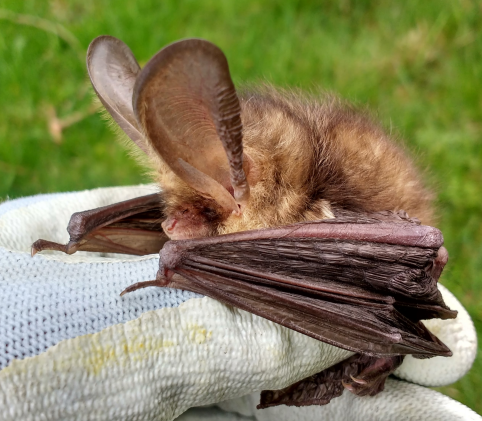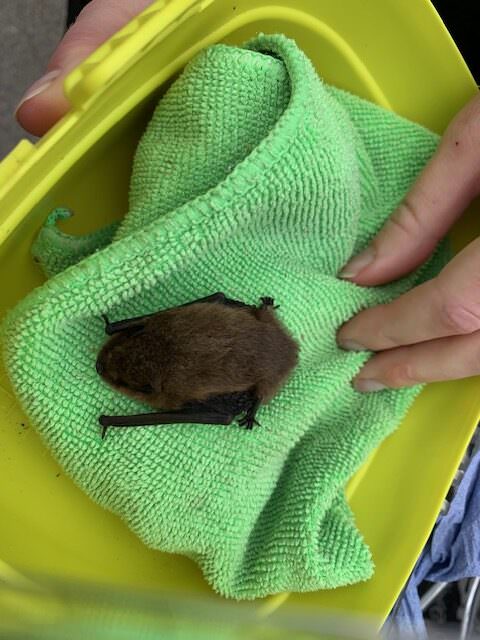
(Photo courtesy of Aileen Salway of a brown long-eared bat)
Bats are our only flying mammal. Due to a 55% decline in numbers since the 1960’s in the UK, their breeding and resting places are protected by law.
Bats are also the inspiration of much ghoulish folklore and are of course rolled out in costume form on Halloween accompanying witches and vampires !
The oldest bat fossils though tell us an amazing story which is that they have been on the earth for 52 million years ! Surely any species that has been around this long deserves our curiosity and respect.
Here in the Park Ecovillage Findhorn, where I have lived since 2012, we are lucky to have a small but widespread bat population.

My own love affair with bats began when I was 4 years old and living in a Cumbrian keep. I remember being woken by my dad one night and with great excitement being brought down stairs with my brother. There, attached to the sitting room curtain, was a bat that had somehow ventured inside.
I marvelled at the sight of such a tiny creature with long ears which looked decidedly weird. Added to which it was hanging upside down which seemed even more peculiar. This certainly spiked my curiosity.
My hope for our coming generations is that they too will have magical, real life bat encounters that will make them want to protect and care for this species as they are truly extraordinary creatures.
Recently between April- August 2024, I carried out a bat survey in Park Ecovillage Findhorn and surrounds.
This was prompted by the fact that our human settlement is going through a lot of change. As more development is being discussed, I wanted to get a more detailed picture of what bat species live here; what habitats they are using and where they are roosting so that we can not only protect them but also help them thrive.
One of the Findhorn communities foundational values that drew me to live here is ‘co creation with nature’. People have different ways of interpreting what this means to them of course. For me, co creation can only really begin when we first truly get to know species other than ourselves, through observation and from that learn what their needs are. Then the partnership can begin !
My research methods in the survey developed as I went along. I started off with a heterodyne bat detector. Going out just before sunset (around which time most bats emerge from their roosts.)
This detector makes the echolocation calls made by some bat species audible to the human ear.
The common pipistrelle, actually makes really loud high frequency sounds at around 120 decibels. At 80 decibels we humans need to wear noise protectors. So perhaps it is just as-well that pipistrelle calls are outside our normal human hearing range otherwise it could be quite deafening to be out at dusk !
As I have mentioned bats navigate using a remarkable system, shared by dolphins and whales, called echolocation. They create sound pictures of their environment by emitting high frequency calls which bounce back to them off objects.
A fleshy spike called a tragus in the bats ears receives and interprets the sound telling it how far away an object is. This helps them map their environment, move around safely and most importantly locate insects with incredible accuracy.
A single common pipistrelle bat can devour up to 3000 midges a night. Definitely a reason why we in Scotland might be grateful to them !
Food types vary slightly between species but in general it is insects: mosquitos , beetles , lacewings , spiders and moths.
Once I had located areas where the bats were with the heterodyne detector, I then set up an additional static anabat swift bat detector loaned by NESBATS. This is a more sophisticated detector, which can help distinguish between bat species with greater accuracy by recording bat sounds to an SD card which can then be read as a sonograph on a computer.
The recordings I made were kindly interpreted for me by ecologist and bat specialist, Aileen Salway of NESBATS.
What emerged is exciting.
As expected the most prevalent species in nearly all recordings was the common pipistrelle.
In Hinterland 3 species : common and soprano pipistrelle (both small bats) and Brown long-eared bats were all present.
The sonograph showed that bat activity was high on the nights recorded there on the ride that straddles the south of the woodland burial ground.
Bats use tree lines and hedges for commuting i.e travelling from their homes (roosts) to their foraging areas. So land features that support their echolocation in this way are incredibly important .
Grass rich edge areas and tree canopy also provide a good source of food for bats and the hinterland has been carefully thought out to provide both.
The brown long-eared bat has, I believe, already been documented in the Hinterland so it is good to see it showing up again on these recordings.
These bats have exceptional hearing due to their long ears and tend to live in and hunt near woodland. They have a slower flight and can hover and take insects off leaves or grass. Moths are their favourite food.They tend to be more difficult to see due to their later emergence in the night than other species.
The bat recordings from Cullerne Garden’s pond identified all the above species plus one more: the natterers bat.
This bat also showed up in the north end of Mr Bickens land bordering the ecovillage and in Pineridge by the quiet garden. It is a medium sized bat characterised by its slightly white underbelly and is less common. It likes areas withwater but will also feed in pine plantations
An interesting project in in Tentsmuir forest in Fife has found natterers maternity roosts sometimes high up in mature Corsican and Scot’s pine where the main trunk branch has divided creating a crevice.
Identifying roosts is challenging as bats will roost in different places at different times of year. The locations can range from in mature trees under thick bark flaps and hollows to attic roof spaces and under soffits and tiles.
Females tender to gather together to form maternity roosts in May/June where they raise just one pup a year who they feed on their own milk for 3 weeks.
They tend to look for very warm, dry places that are sheltered for this purpose.
The young are particularly vulnerable to predation by cats when learning to fly in August as they sometimes get stuck on the ground.
So one way you can help bats in your area is to keep your moggies in at night over this month !
Mating roosts are taken up in Sept/Oct time and hibernation roosts are also scouted out for the Winter.
Gradually as the weather gets colder and there are less insects bats will begin to spend more and more time in torpor eventually going into full hibernation in November.
During hibernation, a bat’s heartbeat can drop to about 20 beats per minute.
Hibernation sites need to be cool and at a constant temperature, usually between 0-9C, where the bats will stay over the Winter until as late as April in Scotland.
Obviously this pattern of changing roosts at different times in their yearly cycle can make bats vulnerable to human activity.
So tree felling, especially of those with roost potential, over the Winter and demolition or renovation of old buildings at any time needs to be done with care and awareness of what bat signs to look for.
Mapping roosts is a useful step in this process to avoid unwittingly causing harm to a bat population.
It is also a task which demands a lot of time and patience. Tracking which direction the bats are flying in and back tracking to see where they are emerging from. As well as looking for other tell tale signs such as bat droppings or moth wings and watching potential sites for that critical moment just either side of sunset when most bats emerge.
If you feel inspired to get involved in mapping bats and their habitat on the Findhorn peninsular, please do get in touch with me. I would love to hear from you.
Saille Mawson
(Nesbats member and committee member for Scottish WildLife Trust NE Branch) [email protected]

















Bats by Saille Mawson
(Photo courtesy of Aileen Salway of a brown long-eared bat)
Bats are our only flying mammal. Due to a 55% decline in numbers since the 1960’s in the UK, their breeding and resting places are protected by law.
Bats are also the inspiration of much ghoulish folklore and are of course rolled out in costume form on Halloween accompanying witches and vampires !
The oldest bat fossils though tell us an amazing story which is that they have been on the earth for 52 million years ! Surely any species that has been around this long deserves our curiosity and respect.
Here in the Park Ecovillage Findhorn, where I have lived since 2012, we are lucky to have a small but widespread bat population.
My own love affair with bats began when I was 4 years old and living in a Cumbrian keep. I remember being woken by my dad one night and with great excitement being brought down stairs with my brother. There, attached to the sitting room curtain, was a bat that had somehow ventured inside.
I marvelled at the sight of such a tiny creature with long ears which looked decidedly weird. Added to which it was hanging upside down which seemed even more peculiar. This certainly spiked my curiosity.
My hope for our coming generations is that they too will have magical, real life bat encounters that will make them want to protect and care for this species as they are truly extraordinary creatures.
Recently between April- August 2024, I carried out a bat survey in Park Ecovillage Findhorn and surrounds.
This was prompted by the fact that our human settlement is going through a lot of change. As more development is being discussed, I wanted to get a more detailed picture of what bat species live here; what habitats they are using and where they are roosting so that we can not only protect them but also help them thrive.
One of the Findhorn communities foundational values that drew me to live here is ‘co creation with nature’. People have different ways of interpreting what this means to them of course. For me, co creation can only really begin when we first truly get to know species other than ourselves, through observation and from that learn what their needs are. Then the partnership can begin !
My research methods in the survey developed as I went along. I started off with a heterodyne bat detector. Going out just before sunset (around which time most bats emerge from their roosts.)
This detector makes the echolocation calls made by some bat species audible to the human ear.
The common pipistrelle, actually makes really loud high frequency sounds at around 120 decibels. At 80 decibels we humans need to wear noise protectors. So perhaps it is just as-well that pipistrelle calls are outside our normal human hearing range otherwise it could be quite deafening to be out at dusk !
As I have mentioned bats navigate using a remarkable system, shared by dolphins and whales, called echolocation. They create sound pictures of their environment by emitting high frequency calls which bounce back to them off objects.
A fleshy spike called a tragus in the bats ears receives and interprets the sound telling it how far away an object is. This helps them map their environment, move around safely and most importantly locate insects with incredible accuracy.
A single common pipistrelle bat can devour up to 3000 midges a night. Definitely a reason why we in Scotland might be grateful to them !
Food types vary slightly between species but in general it is insects: mosquitos , beetles , lacewings , spiders and moths.
Once I had located areas where the bats were with the heterodyne detector, I then set up an additional static anabat swift bat detector loaned by NESBATS. This is a more sophisticated detector, which can help distinguish between bat species with greater accuracy by recording bat sounds to an SD card which can then be read as a sonograph on a computer.
The recordings I made were kindly interpreted for me by ecologist and bat specialist, Aileen Salway of NESBATS.
What emerged is exciting.
As expected the most prevalent species in nearly all recordings was the common pipistrelle.
In Hinterland 3 species : common and soprano pipistrelle (both small bats) and Brown long-eared bats were all present.
The sonograph showed that bat activity was high on the nights recorded there on the ride that straddles the south of the woodland burial ground.
Bats use tree lines and hedges for commuting i.e travelling from their homes (roosts) to their foraging areas. So land features that support their echolocation in this way are incredibly important .
Grass rich edge areas and tree canopy also provide a good source of food for bats and the hinterland has been carefully thought out to provide both.
The brown long-eared bat has, I believe, already been documented in the Hinterland so it is good to see it showing up again on these recordings.
These bats have exceptional hearing due to their long ears and tend to live in and hunt near woodland. They have a slower flight and can hover and take insects off leaves or grass. Moths are their favourite food.They tend to be more difficult to see due to their later emergence in the night than other species.
The bat recordings from Cullerne Garden’s pond identified all the above species plus one more: the natterers bat.
This bat also showed up in the north end of Mr Bickens land bordering the ecovillage and in Pineridge by the quiet garden. It is a medium sized bat characterised by its slightly white underbelly and is less common. It likes areas withwater but will also feed in pine plantations
An interesting project in in Tentsmuir forest in Fife has found natterers maternity roosts sometimes high up in mature Corsican and Scot’s pine where the main trunk branch has divided creating a crevice.
Identifying roosts is challenging as bats will roost in different places at different times of year. The locations can range from in mature trees under thick bark flaps and hollows to attic roof spaces and under soffits and tiles.
Females tender to gather together to form maternity roosts in May/June where they raise just one pup a year who they feed on their own milk for 3 weeks.
They tend to look for very warm, dry places that are sheltered for this purpose.
The young are particularly vulnerable to predation by cats when learning to fly in August as they sometimes get stuck on the ground.
So one way you can help bats in your area is to keep your moggies in at night over this month !
Mating roosts are taken up in Sept/Oct time and hibernation roosts are also scouted out for the Winter.
Gradually as the weather gets colder and there are less insects bats will begin to spend more and more time in torpor eventually going into full hibernation in November.
During hibernation, a bat’s heartbeat can drop to about 20 beats per minute.
Hibernation sites need to be cool and at a constant temperature, usually between 0-9C, where the bats will stay over the Winter until as late as April in Scotland.
Obviously this pattern of changing roosts at different times in their yearly cycle can make bats vulnerable to human activity.
So tree felling, especially of those with roost potential, over the Winter and demolition or renovation of old buildings at any time needs to be done with care and awareness of what bat signs to look for.
Mapping roosts is a useful step in this process to avoid unwittingly causing harm to a bat population.
It is also a task which demands a lot of time and patience. Tracking which direction the bats are flying in and back tracking to see where they are emerging from. As well as looking for other tell tale signs such as bat droppings or moth wings and watching potential sites for that critical moment just either side of sunset when most bats emerge.
If you feel inspired to get involved in mapping bats and their habitat on the Findhorn peninsular, please do get in touch with me. I would love to hear from you.
Saille Mawson
(Nesbats member and committee member for Scottish WildLife Trust NE Branch) [email protected]